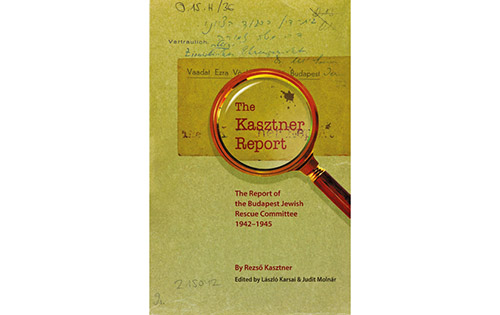
Reviewing: “The Kasztner Report: The Report of the Budapest Jewish Rescue Committee 1942-1945” by Rezső Kasztner. Yad Vashem, The International Institute for Holocaust Research. 2013. 393 pages. ISBN-13: 978-965-308-443-8
‘Blood for Goods’
In the introduction to “The Kasztner Report,” historians László Karsai, professor of history at the University of Szeged in Hungary, and Judit Molnár, deputy director of the Hungarian research group of the Yad Vashem Archives, explain that one of the most contentious, divisive and debated episodes of the Shoah involved Rezső (Rudolph) Kasztner. As they pointed out, you either glorified Rudolph Kasztner or “despised him as a traitor of the persecuted.” During the German occupation in 1944, Kasztner negotiated with Adolf Eichmann, “a central figure” in implementing the “Final Solution,” and Kurt Becher, chief of the economic department of the SS Command in Hungary, to exchange Jews for military trucks and “other goods of great quantity.”
Who Was Rudolph Kasztner?
As historian Yehuda Bauer noted, Kasztner was born in Cluj (Kolozsvar in Hungarian) in northern Transylvania, in 1906. Kasztner served as a parliamentary correspondent in Bucharest before Hungary annexed Transylvania in 1940. Once he became a Hungarian citizen, Kasztner moved to Bucharest. As a member of the center-left Zionists Ihud, an extension of the Palestine Jewish Labor Party (Mapai), he sought out members of the Zionist movement. He found they did not amount to more than 5% of the Jews in the country. Most of the approximately 800,000 Hungarian Jews, Bauer observed, were “patriotic Hungarians,” who “were organized into mutually hostile groups.” Approximately one-third were Orthodox, and some two-thirds were connected in some way to the Neolog community, which is similar in belief to American Conservative Judaism.
Who Was Joel Brand?
Joel Brand was a kindred spirit who was also born in 1906 in Transylvania, Bauer wrote. Brand was “a middle-rank communist functionary,” whom the Nazis arrested in 1933 in Thuringia in central Germany. After being released in 1934, he eventually came to live in Budapest, where he became a member of Ihud. When the Kamenets-Podolsk deportations of foreign nationals living in Hungary began (August 27-28, 1941) after Hungary declared war on the Soviet Union on June 27, 1941, Brand contacted Joszef Krem, a Hungarian espionage agent, for help to save Jews. For a large sum of money, Krem succeeded in securing Brand’s wife’s sister’s release. Brand contacted other families and Krem had them freed as well after being paid generously.
This experience led Brand, Kasztner and Samuel Springmann, another center-left Zionist, to begin smuggling and aiding Jewish refugees. Attempts to enlist Hungarian Social Democrats failed, for as Bauer noted, they were unwilling to risk their lives for Jews. Otto Komoly, a distinguished Budapest engineer, reserve officer, war veteran and Zionist leader, became chairman of the group and the unifier. In early 1943, Komoly and Kasztner founded the Relief and Rescue Committee of Budapest (Va’adat ha-Ezra ve-ha-Hatsala be-Budapest, known as the Va’ada).
German Occupation of Hungary: March 1944
After Hitler invaded Hungary on March 19, 1944, the country’s Jews were rounded up and deported to Auschwitz at the rate of 12,000 a day. The focus of the Relief and Rescue Committee turned to negotiations with the SS to exchange people for military hardware and trucks, referred to as “Blood for Goods.” Beginning in April 1944, Kasztner and Brand entered into negotiations with Adolf Eichmann, and SS officer Dieter Wisliceny, his deputy, in the hope of suspending deportations of Jews from Hungary. In late April 1944, Eichmann proposed “selling” 10,000 Jews in exchange for trucks delivered to the Nazis. Brand traveled to Turkey to present the proposal to the Allies and representatives of the Yishuv (the Jewish community in Palestine). After Brand failed to return from Istanbul, Kasztner took over negotiations with Eichmann and Kurt Becher, even as the mass deportation of Hungarian Jews began in May 1944. From May 14-15 to July 9, 1944 (57 days), 437,000 Jews were deported.
The book raises a number of fundamental questions about Hungarian Jewry: What did they know about the ghettos and extermination camps and when? How did they respond to the news? Could the Jewish masses have resisted, revolted or escaped? What role did the Judenräte (Jewish Councils) play during this period? Is the intense criticism of their behavior justified? How did the majority of the Hungarian population and political elite respond to what was happening to the Jews?
Kastner Train
Kastner had no illusion that even had the Germans received 10,000 trucks, they would have released hundreds of thousands of Jews. Yet, despite all odds, Kastner and his group “contributed considerably to the final rescue of 200,000 Budapest Jews,” according to Yehuda Bauer. He argued, “It is more than likely they had a hand in the rescue of more than 10,000 Hungarian Jews who were deported to the area around Vienna (Strasshof) instead of Auschwitz; and it is clear that Kastner succeeded in rescuing 1,684 people, including his family and friends, on the so-called Kastner train,” who were transported to Bergen-Belsen, and from there in two groups to Switzerland in August and December 1944.
A Final Note
The authors emphasize that historians are not judges or attorneys, and certainly not counsels for the defense. Their task is to acquire information and interpret the material they collect. Rezső Kasztner’s Report is a vital source of information for those interested in understanding “who did what and why in Hungary in 1944 to save Jews or to destroy them.”
Dr. Alex Grobman is senior resident scholar at the John C. Danforth Society and a member of the Council of Scholars for Peace in the Middle East.













